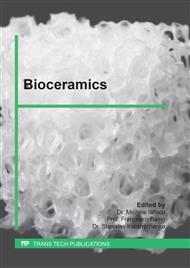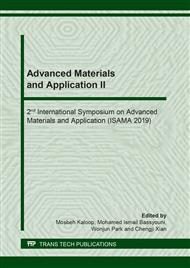[1]
W. Cao, L. L. Hench, Bioactive materials, Ceram. Int. 22 (1996) 493-507.
Google Scholar
[2]
V. V. Silva, F. S. Lameiras, R. Z. Domingues, Microstructural and mechanical study of zirconia-hydroxyapatite (ZH) composite ceramics for biomedical applications, Compos. Sci. Technol. 61 (2001) 301-310.
DOI: 10.1016/s0266-3538(00)00222-0
Google Scholar
[3]
S. Ramesh, C. Y. Tan, W. H. Yeo, R. Tolouei, M. Amiriyan, I. Sopyan, W. D. Teng, Effects of bismuth oxide on the sinterability of hydroxyapatite, Ceram. Int. 37 (2011) 599-606.
DOI: 10.1016/j.ceramint.2010.09.041
Google Scholar
[4]
J. P. Gittings, C. R. Bowen, I. G. Turner, F. Baxter, J. Chaudhuri, Characterisation of ferroelectric-calcium phosphate composites and ceramics, J. Eur. Ceram. Soc. 27 (2007) 4187-4190.
DOI: 10.1016/j.jeurceramsoc.2007.02.120
Google Scholar
[5]
A. K. Dubey, G. Tripathi, B. Basu, Characterization of hydroxyapatite-perovskite (CaTiO3) composites: Phase evaluation and cellular response, J. Biomed. Mater. Res. B. 95 (2010) 320-329.
DOI: 10.1002/jbm.b.31716
Google Scholar
[6]
K. Ravikumar, P. K. Mallik, B. Basu, Twinning induced enhancement of fracture toughness in ultrafine grained Hydroxyapatite-Calcium Titanate composites, J. Eur. Ceram. Soc. 36 (2016) 805-815.
DOI: 10.1016/j.jeurceramsoc.2015.10.044
Google Scholar
[7]
E. A. Olevsky, Theory of sintering: from discrete to continuum. Mater. Sci. Eng. R. 23 (1998) 41-100.
Google Scholar
[8]
W. Liang, D. Xiao, W. Wu, X. Li, Y. Sun, J. Zhu, Effect of sintering temperature on phase transitions, properties and temperature stability of (K0.465Na0.465Li0. 07)(Nb0.95Sb0.05)O3 lead-free piezoelectric ceramics. Curr. Appl. Phys. 11 (2011) S138-S142.
DOI: 10.1016/j.cap.2011.03.040
Google Scholar
[9]
C. Kruea-In, W. Udsah, S. Eitssayeam, K. Pengpat, G. Rujijanagul, Influence of processing temperature on properties of Sr(Fe0.5Nb0.5)O3 high dielectric ceramics. Ferroelectric. 456 (2013) 128-133.
DOI: 10.1080/00150193.2013.846709
Google Scholar
[10]
S. Inthong, T. Tunkasiri, S. Eitssayeam, K. Pengpat, G. Rujijanagul, Physical properties and bioactivity of nanocrystalline hydroxyapatite synthesized by a co-precipitation route, Ceram. Int. 39 (2013) S533-S536.
DOI: 10.1016/j.ceramint.2012.10.129
Google Scholar
[11]
C. Kruea-In, T. Monmakhan, G. Rujijanagul, Electrical and physical properties of modified potassium sodium niobate ceramics prepared by molten salt synthesis, Ferroelectrics. 452 (2013) 69-75.
DOI: 10.1080/00150193.2013.841510
Google Scholar
[12]
A. Niakan, S. Ramesh, P. Ganesan, C. Y. Tan, J. Purbolaksono, H. Chandran, S. Ramesh, W. D. Teng, Sintering behaviour of natural porous hydroxyapatite derived from bovine bone, Ceram. Int. 41 (2015) 3024-3029.
DOI: 10.1016/j.ceramint.2014.10.138
Google Scholar
[13]
G. Muralithran, S. Ramesh, The effects of sintering temperature on the properties of hydroxyapatite, Ceram. Int. 26 (2000) 221-230.
DOI: 10.1016/s0272-8842(99)00046-2
Google Scholar
[14]
S. Ramesh, K. L. Aw, R. Tolouei, M. Amiriyan, C. Y. Tan, M. Hamdi, J. Purbolaksono, M. A. Hassn, W. D. Teng, Sintering properties of hydroxyapatite powders prepared using different methods, Ceram. Int. 39 (2013) 111-119.
DOI: 10.1016/j.ceramint.2012.05.103
Google Scholar
[15]
R. M German, Sintering theory and practice, John Wiley & Sons, New York, 1996, ISBN 047105786.
Google Scholar



